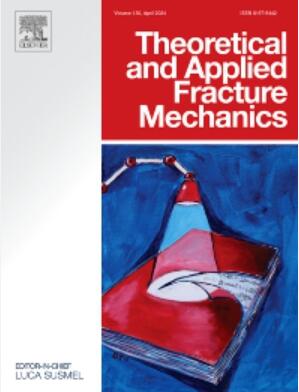冲击荷载作用下双直顶拱隧道力学特性及动力断裂行为
IF 5.6
2区 工程技术
Q1 ENGINEERING, MECHANICAL
引用次数: 0
摘要
本研究旨在探讨爆破、钻孔、机械振动等外部动荷载对双直顶拱隧道稳定性的影响。采用分离式霍普金森压杆(SHPB)装置对TSWTA隧道试件进行了动态冲击试验。系统地探讨了试件的动态力学特性和能量演化规律。此外,基于DIC技术分析了TSWTA隧道试件的应变演化规律和破坏模式。结果表明:TSWTA隧道的存在削弱了岩石的动抗压强度,并且随着双隧道间距的增加,这种削弱作用更加明显。随着TSWTA隧道试件间距的增大,试件的耗散能密度指数呈减小趋势,表明试件破坏程度逐渐减小。TSWTA隧道内拱顶与内底之间的连接区域最先出现应变集中和开裂。随着隧道间距的增大,裂纹萌生时间和扩展速率逐渐减小。此外,TSWTA隧道之间相互连接的裂缝导致中心岩柱松动破坏。随着隧道间距的增大,中心岩柱的破坏程度和位移逐渐减小。原始拉伸裂纹与水平方向的夹角β逐渐减小。本文章由计算机程序翻译,如有差异,请以英文原文为准。
Mechanical characterization and dynamic fracture behavior of twin straight-wall-top-arch tunnels under impact loading
This research aims to investigate the effect of external dynamic loads such as blasting, drilling, and mechanical vibrations on the stability of twin straight-wall-top-arch (TSWTA) tunnels. Dynamic impact tests on TSWTA tunnel specimens are carried out by employing the split Hopkinson pressure bar (SHPB) device. The dynamic mechanical characteristics and energy evolution law of the specimens are also methodically explored. In addition, the strain evolution laws and failure modes of TSWTA tunnel specimens are analyzed based on the DIC technique. The results indicate that the presence of TSWTA tunnels weakens the dynamic compressive strength of the rock, and such a weakening effect becomes more pronounced as the spacing between the twin tunnels increases. As the spacing of the TSWTA tunnel specimens increases, the dissipated energy density index of the specimens tends to decrease, indicating a gradual decrease in the degree of specimen failure. The connection regions between the inner vaults of the TSWTA tunnels and the connection regions between their inner bottom are the first to exhibit strain concentration and cracking. As the spacing of the TSWTA tunnels increases, the crack initiation time and propagation rate gradually decrease. Additionally, the interconnected cracks between the TSWTA tunnels result in the loosening and failure of the central rock pillar. With increasing spacing between the TSWTA tunnels, both the degree of failure and the displacement of the central rock pillar gradually decrease. Furthermore, the angle β between the primary tensile crack and the horizontal direction gradually decreases.
求助全文
通过发布文献求助,成功后即可免费获取论文全文。
去求助
来源期刊

Theoretical and Applied Fracture Mechanics
工程技术-工程:机械
CiteScore
8.40
自引率
18.90%
发文量
435
审稿时长
37 days
期刊介绍:
Theoretical and Applied Fracture Mechanics'' aims & scopes have been re-designed to cover both the theoretical, applied, and numerical aspects associated with those cracking related phenomena taking place, at a micro-, meso-, and macroscopic level, in materials/components/structures of any kind.
The journal aims to cover the cracking/mechanical behaviour of materials/components/structures in those situations involving both time-independent and time-dependent system of external forces/moments (such as, for instance, quasi-static, impulsive, impact, blasting, creep, contact, and fatigue loading). Since, under the above circumstances, the mechanical behaviour of cracked materials/components/structures is also affected by the environmental conditions, the journal would consider also those theoretical/experimental research works investigating the effect of external variables such as, for instance, the effect of corrosive environments as well as of high/low-temperature.
 求助内容:
求助内容: 应助结果提醒方式:
应助结果提醒方式:


